New Year Social, 20th January 2015
Margaret
Margaret
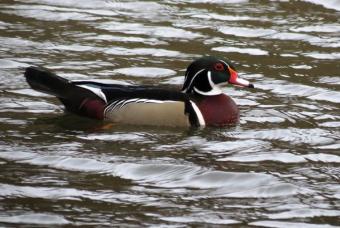 Wood DuckThe 2015 BEES year got off to a very pleasant start with Donald leading us on our annual New Year’s walk, this year in the Aire Valley. A skein of greylag geese greeted the minibus’s arrival at the starting point in Bingley and after a delay due to some difficulty in rounding up all the day’s participants we set off in slight drizzle and made our way along the Leeds & Liverpool canal (where we were surpised to see a male wood duck swimming with two greylag geese) to Dowley Gap thence along the banks of the River Aire to Hirst weir. On this stretch we were lucky to have fine views of two kingfishers and two little grebes but there was no sign of the elusive lesser spotted woodpecker which lives in the woods hereabouts. A gaggle of Canada geese were feeding in a nearby field (John reminding us that a flock of geese in the air assumes a different name on landing), with redwings and mistle thrushes in attendance.
Wood DuckThe 2015 BEES year got off to a very pleasant start with Donald leading us on our annual New Year’s walk, this year in the Aire Valley. A skein of greylag geese greeted the minibus’s arrival at the starting point in Bingley and after a delay due to some difficulty in rounding up all the day’s participants we set off in slight drizzle and made our way along the Leeds & Liverpool canal (where we were surpised to see a male wood duck swimming with two greylag geese) to Dowley Gap thence along the banks of the River Aire to Hirst weir. On this stretch we were lucky to have fine views of two kingfishers and two little grebes but there was no sign of the elusive lesser spotted woodpecker which lives in the woods hereabouts. A gaggle of Canada geese were feeding in a nearby field (John reminding us that a flock of geese in the air assumes a different name on landing), with redwings and mistle thrushes in attendance. 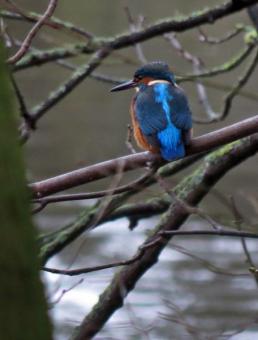 Kingfisher
Leaving the river we made our way to the end of Coach Road and started the gentle uphill climb through the Milner Field Estate, formerly occupied by Titus Salt jnr. Here we had the unusual sight of a flock of seven grey herons seemingly resting in a field. By the time we had reached the far side of the Milner Field Estate at Primrose Lane the weather had brightened and we made our way back down to the river and canal in ever-improving weather, lunching in sunshine at Dowley Gap locks before re-tracing our route back to Bingley.
Kingfisher
Leaving the river we made our way to the end of Coach Road and started the gentle uphill climb through the Milner Field Estate, formerly occupied by Titus Salt jnr. Here we had the unusual sight of a flock of seven grey herons seemingly resting in a field. By the time we had reached the far side of the Milner Field Estate at Primrose Lane the weather had brightened and we made our way back down to the river and canal in ever-improving weather, lunching in sunshine at Dowley Gap locks before re-tracing our route back to Bingley.
 Weir
Being early January, there was little in the way of plant life to be seen, although hazel catkins were filling nicely and we admired the numerous small black berries which Donald advised were of wild privet. Fungi was evident in a few places with a nice clump of turkey tail being the most prominent.
Weir
Being early January, there was little in the way of plant life to be seen, although hazel catkins were filling nicely and we admired the numerous small black berries which Donald advised were of wild privet. Fungi was evident in a few places with a nice clump of turkey tail being the most prominent.
Illness had reduced our numbers and many familiar BEES faces were missing but we were able to welcome two new members, David & Sally, together with Dorothy who had been on just one previous trip. They were all very welcome and everyone seemed to enjoy the short day out.
Many thanks to Donald who undertook the leadership duties with his usual efficiency and to Sue for her excellent driving.
Stuart
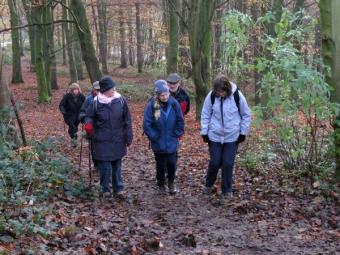 Walking Through The WoodAs the minibus headed from Bradford towards Leeds on our annual Mystery Outing the odds-on favourite destination amongst the 14 members appeared to be Roundhay Park, so there was some surprise when we drew into the car park at Temple Newsam.
Walking Through The WoodAs the minibus headed from Bradford towards Leeds on our annual Mystery Outing the odds-on favourite destination amongst the 14 members appeared to be Roundhay Park, so there was some surprise when we drew into the car park at Temple Newsam.
This is an admirable destination for a November visit, being not too far to travel whilst offering a variety of activities and facilities. There was a decision to be made for some – 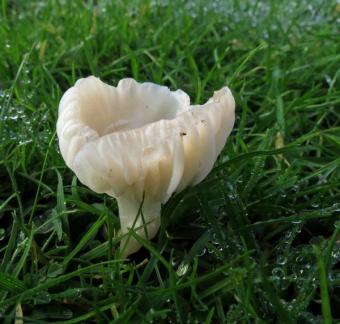 Snowy Waxcap do we visit the house first and have a walk afterwards or do it the other way round. Three opted for the house first and the rest of the group wandered through the woodland area to see what treats a fine late autumn day might provide. There was immediately another mystery waiting to be solved – where had Robert disappeared to?
Snowy Waxcap do we visit the house first and have a walk afterwards or do it the other way round. Three opted for the house first and the rest of the group wandered through the woodland area to see what treats a fine late autumn day might provide. There was immediately another mystery waiting to be solved – where had Robert disappeared to?
Bird life was reasonably plentiful, but limited in variety of species and whilst mistle thrushes were about, we had only ‘possible’ sightings of redwing and fieldfare from Donald. We had better luck with fungi species, of which John recorded about 15 with sulphur tuft being the most common and the most spectacular with one large group being especially attractive. There was still some late autumn colour in the grounds - the most colourful species being Maidenhair-tree (Ginkgo biloba) and Persian Ironwood (Parrotia persica) – Veronica’s favourite tree.
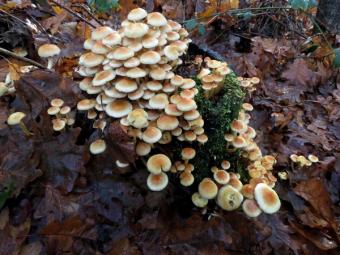 Sulphur Tuft
Visitors to the house reported a very interesting morning – they had enjoyed a tour of the cellars and admired an exhibition of tapestries by popular cross-dressing artist Grayson Perry. After lunching in continuing fine weather more of the party visited the house whilst others continued to explore the grounds but all met up in the café before the scheduled departure time where the second mystery was solved when Robert appeared. He had taken himself off to do a spot of bird watching around the parkland and Home Farm and was able to report seeing sparrowhawk and goosander, neither of which was seen by the rest of the group.
Sulphur Tuft
Visitors to the house reported a very interesting morning – they had enjoyed a tour of the cellars and admired an exhibition of tapestries by popular cross-dressing artist Grayson Perry. After lunching in continuing fine weather more of the party visited the house whilst others continued to explore the grounds but all met up in the café before the scheduled departure time where the second mystery was solved when Robert appeared. He had taken himself off to do a spot of bird watching around the parkland and Home Farm and was able to report seeing sparrowhawk and goosander, neither of which was seen by the rest of the group.
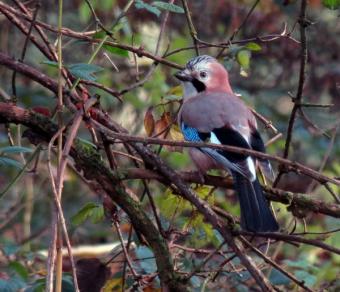 Jay
Unfortunately joint-leader Joan had fallen sick and couldn’t be with us on the day, but co-joint-leader Marilyn managed to look after us all on her own and ensured that the full complement of 14 returned to the minibus at the appointed hour for departure. As we had crawled slowly around the Leeds Ring Road to reach our destination, we decided to try the motorway route for our return which we accomplished in good time to round off a most enjoyable day. Many thanks to Marilyn and Joan for organising this popular event and to Robert for undertaking the driving.
Jay
Unfortunately joint-leader Joan had fallen sick and couldn’t be with us on the day, but co-joint-leader Marilyn managed to look after us all on her own and ensured that the full complement of 14 returned to the minibus at the appointed hour for departure. As we had crawled slowly around the Leeds Ring Road to reach our destination, we decided to try the motorway route for our return which we accomplished in good time to round off a most enjoyable day. Many thanks to Marilyn and Joan for organising this popular event and to Robert for undertaking the driving.
Stuart
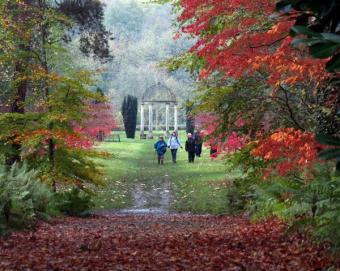 View Towards The MonumentA nearly full minibus arrived at Thorp Perrow in overcast but mercifully dry conditions for this week's outing. It remained dry throughout our time at the arboretum allowing the group to divide up and explore as they wished. Many trees had completely shed their leaves but many were still displaying fabulous autumn colours. Some of our group were looking for the "Geoffrey Appleyard" trees and Stuart was eager to learn from Amanda's extensive tree knowledge.
View Towards The MonumentA nearly full minibus arrived at Thorp Perrow in overcast but mercifully dry conditions for this week's outing. It remained dry throughout our time at the arboretum allowing the group to divide up and explore as they wished. Many trees had completely shed their leaves but many were still displaying fabulous autumn colours. Some of our group were looking for the "Geoffrey Appleyard" trees and Stuart was eager to learn from Amanda's extensive tree knowledge. 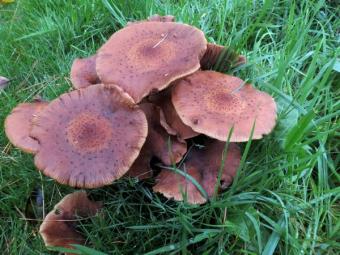 Honey Fungus
A fair few fungi were seen including honey fungus, trooping funnel, silver leaf fungus, smoky bracket and bleeding broad leaf crust. There were few birds but highlights included nuthatch, little grebe and a sighting of flocks of redwing and fieldfare.
Most of the group viewed the early afternoon birds of prey flying display in the wildlife park, when three birds of prey were on show:
Honey Fungus
A fair few fungi were seen including honey fungus, trooping funnel, silver leaf fungus, smoky bracket and bleeding broad leaf crust. There were few birds but highlights included nuthatch, little grebe and a sighting of flocks of redwing and fieldfare.
Most of the group viewed the early afternoon birds of prey flying display in the wildlife park, when three birds of prey were on show: 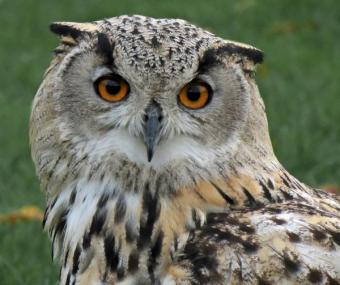 Colinthe Jackal Buzzard, the Turkmenistan eagle owl and the Saker Falcon. Colin, the Turkmenistan eagle owl had the unfortunate reputation of being the laziest of the captive birds. This was demonstrated by his quite comical ungainly walk when released from his enclosure. He certainly seemed relucant to take to the wing. The buzzard and the falcon gave impressive flying displays which were uncomfortably close to some viewers heads!
The tea rooms provided welcome refreshment at the end of the day before we headed back to Bradford via the scenic route. Thanks to Joan for leading today's trip and Robert and Sue for sharing the driving.
Colinthe Jackal Buzzard, the Turkmenistan eagle owl and the Saker Falcon. Colin, the Turkmenistan eagle owl had the unfortunate reputation of being the laziest of the captive birds. This was demonstrated by his quite comical ungainly walk when released from his enclosure. He certainly seemed relucant to take to the wing. The buzzard and the falcon gave impressive flying displays which were uncomfortably close to some viewers heads!
The tea rooms provided welcome refreshment at the end of the day before we headed back to Bradford via the scenic route. Thanks to Joan for leading today's trip and Robert and Sue for sharing the driving. Sue
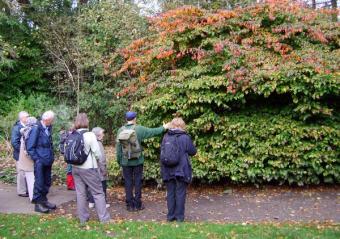 Looking At Persian IronwoodConditions were ideal for this late autumn visit to the Hollies. It was warm and dry during the course of our visit. The colours of the trees were glorious. The Hollies is a Leeds park and a hidden treasure unknown even to long standing residents of Leeds. It wa given to the council in 1918 by George Brown in memory of his son Harold who died fighting in the First World War. Gordon Cooper, a fine plantsman, developed the estate adding specimen trees. Our group was joined in the morning by friends from the Bradford Botany Group - Bruce, Carmen and Phyll. Also we welcomed a new member Dorothy making us a party of 14.
Looking At Persian IronwoodConditions were ideal for this late autumn visit to the Hollies. It was warm and dry during the course of our visit. The colours of the trees were glorious. The Hollies is a Leeds park and a hidden treasure unknown even to long standing residents of Leeds. It wa given to the council in 1918 by George Brown in memory of his son Harold who died fighting in the First World War. Gordon Cooper, a fine plantsman, developed the estate adding specimen trees. Our group was joined in the morning by friends from the Bradford Botany Group - Bruce, Carmen and Phyll. Also we welcomed a new member Dorothy making us a party of 14.
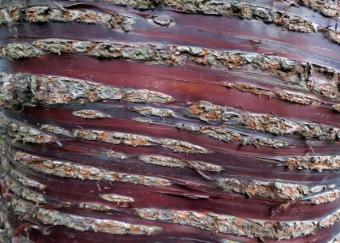 Tibetan Cherry Tree BarkBruce led the morning tour of the two gardens and environs. His knowledge was invaluable to us in the identification of species.The two gardens contain an excellent collection of exotic trees from all parts of the world - Japan, China, the Americas which had been planted at the beginning of the 20th century. Bruce quickly guided us through some of the trees' characteristics - bark, leaves and at this time of year, fruit. The collection is particularly attractive in its flowering period in the spring. In the first garden we looked at Manchurian Walnut and Snakebark Maple. Moving into the park we admired Turkish Hazel , Persian Ironwood and Tibetan Cherry. Onward into the second garden we appreciated the Kausa Dogwood, Blue Bean Tree, Judas Tree, Foxglove Tree, Tree of Heaven and Black Beech. Our walk continued below the gardens where we encountered yet more exotics including the Tulip Tree.
Tibetan Cherry Tree BarkBruce led the morning tour of the two gardens and environs. His knowledge was invaluable to us in the identification of species.The two gardens contain an excellent collection of exotic trees from all parts of the world - Japan, China, the Americas which had been planted at the beginning of the 20th century. Bruce quickly guided us through some of the trees' characteristics - bark, leaves and at this time of year, fruit. The collection is particularly attractive in its flowering period in the spring. In the first garden we looked at Manchurian Walnut and Snakebark Maple. Moving into the park we admired Turkish Hazel , Persian Ironwood and Tibetan Cherry. Onward into the second garden we appreciated the Kausa Dogwood, Blue Bean Tree, Judas Tree, Foxglove Tree, Tree of Heaven and Black Beech. Our walk continued below the gardens where we encountered yet more exotics including the Tulip Tree.
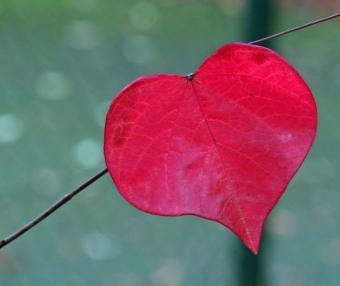 Autumn LeafLunch was taken on the relatively comfortable benches surrounding the tennis courts. In the afternoon we set off on a circular walk which included a steep descent to join the Meanwood Valley Trail. We had a brief stop on the bridge above a waterfall for a photo then continued on the Trail, a road ascent and a return on the flat path through the woods.
The warm temperature and colour of the trees added to our enjoyment of the day. Surprisingly there were several floral species both native and garden still in flower. As the gardener commented, there had been no frost to date this year. Also a specked wood butterfly was spotted. Several fungi species were hunted down by those with a mycological interest. They included Glistening Inkcap, Earthballs, Shaggy Parasol, Shaggy Inkcap, Shaggy Scaly cap, Artist/ Southern Bracket and Turkey Tail. Birds were scarce. A jay was seen, long tailed tits and robin heard. The day was nicely rounded off by the consumption of Sue's delicious mince pies.
Autumn LeafLunch was taken on the relatively comfortable benches surrounding the tennis courts. In the afternoon we set off on a circular walk which included a steep descent to join the Meanwood Valley Trail. We had a brief stop on the bridge above a waterfall for a photo then continued on the Trail, a road ascent and a return on the flat path through the woods.
The warm temperature and colour of the trees added to our enjoyment of the day. Surprisingly there were several floral species both native and garden still in flower. As the gardener commented, there had been no frost to date this year. Also a specked wood butterfly was spotted. Several fungi species were hunted down by those with a mycological interest. They included Glistening Inkcap, Earthballs, Shaggy Parasol, Shaggy Inkcap, Shaggy Scaly cap, Artist/ Southern Bracket and Turkey Tail. Birds were scarce. A jay was seen, long tailed tits and robin heard. The day was nicely rounded off by the consumption of Sue's delicious mince pies.
Margaret
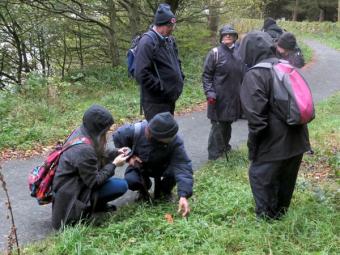 Examining Fungi
Examining FungiThe group was reduced through ill health to only ten. This included Carys, a young BEES volunteer, making her first outing with the group. She informed us that she had a Biology degree and was interested in seeing fungi. She wouldn’t be disappointed.
The weather wasn’t as grand as we are used to and when we arrived it was overcast and slightly drizzly. There was no need for umbrellas, however, as the rather strong north-easterly kept the rain at bay.The outward section of our walk around the reservoir path was directly into the wind so most of us took to wearing headwear. Later on the wind relented and by the time we had our lunch stop at the Blubberhouses car-park the weather was ok for mid-Oct.
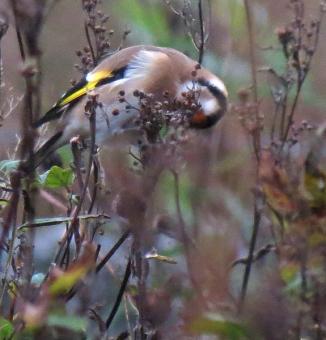 GoldfinchWe were surprised by the low level of water and much of the reservoir was now exposed land. There were plenty of tits and finches plus Treecreeper, Nuthatch and Wren about but not many birds on the water, just a few teal, Canada Geese, Mallard and two Cormorants. A Red Kite was also spotted in a far off tree.
GoldfinchWe were surprised by the low level of water and much of the reservoir was now exposed land. There were plenty of tits and finches plus Treecreeper, Nuthatch and Wren about but not many birds on the water, just a few teal, Canada Geese, Mallard and two Cormorants. A Red Kite was also spotted in a far off tree.
A decent variety of fungi were seen from the path so Carys got her wish. Those that Joan and I were able to ID are as follows; Chicken of the Woods, Common Inkcaps, Turkeytail, Deceiver, Brown Rollrim, Wood Hedgehog, Dead Man’s Fingers, Puffball, Fly Agaric, Larch Bolete, Wrinkled Club, Candlesnuff, Stinkhorn. 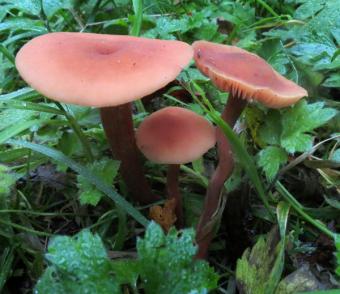 DeceiverWe ignored the little brown jobs and the ones that were well past their sell by dates! A yellow pored bolete with a reddish stem is possibly Red-cracking bolete.
DeceiverWe ignored the little brown jobs and the ones that were well past their sell by dates! A yellow pored bolete with a reddish stem is possibly Red-cracking bolete.
Plants still in flower included; Herb Robert, Red Campion, Aaron’s Rod and Devils Bit Scabious.
As we had got round fairly quickly, Margaret suggested going to Thruscross to see if the hidden village of West End had been exposed by the low water levels. It was, however still underwater. Nevertherless it had been a very pleasant day out and well done to our driver of the day; Robert
John Gavaghan
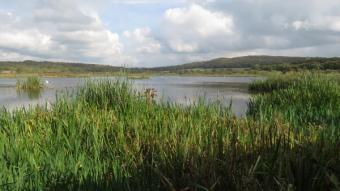 View From A HideThe minibus left Bradford with five people aboard but by the time the final pick up had been made in Keighley a party of thirteen set out expectantly to RSPB Leighton Moss on the last day of a record-breaking dry September which promised fine weather until about 4.00pm. With the possibility of a late-morning sighting of bearded tits, the party was persuaded to forego the accustomed comfort break at Kirkby Lonsdale and we headed straight to our destination where we quickly registered and headed off to the grit trays.
View From A HideThe minibus left Bradford with five people aboard but by the time the final pick up had been made in Keighley a party of thirteen set out expectantly to RSPB Leighton Moss on the last day of a record-breaking dry September which promised fine weather until about 4.00pm. With the possibility of a late-morning sighting of bearded tits, the party was persuaded to forego the accustomed comfort break at Kirkby Lonsdale and we headed straight to our destination where we quickly registered and headed off to the grit trays. 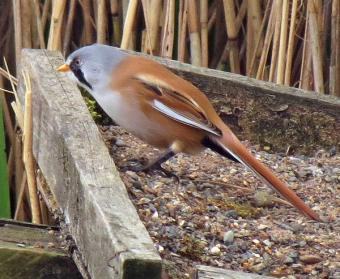 Bearded TitThere were no bearded tits about and the chances of seeing any so late in the morning (by this time going up to noon) were very slim according to our more pessimistic members. However, a ten-minute wait was rewarded when a pair of bearded tits did appear. They were most cooperative and hung around for about ten minutes gathering grit before eventually flying off into the reeds.
Bearded TitThere were no bearded tits about and the chances of seeing any so late in the morning (by this time going up to noon) were very slim according to our more pessimistic members. However, a ten-minute wait was rewarded when a pair of bearded tits did appear. They were most cooperative and hung around for about ten minutes gathering grit before eventually flying off into the reeds.
After this great start to the day the party proceeded to the Public hide where there were many varieties of duck to be seen as we lunched. With so much to see and so many different viewing possibilities, the party then split to follow individual preferences before congregating back at the visitor centre for the short minibus trip to the coastal trail and the Eric Morecambe and Allen hides. Here we were able to see many different species of waders.
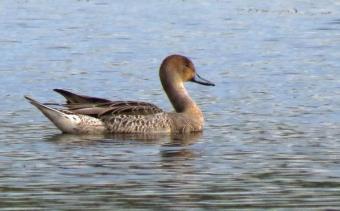 Pintail
Returning to the visitor centre, the option was the cafe or the nearby Lillian’s hide where those opting for the latter were treated to the fine spectacle of scores of black-tailed godwits and both Little and Great egrets amongst the other wader and duck species.
Pintail
Returning to the visitor centre, the option was the cafe or the nearby Lillian’s hide where those opting for the latter were treated to the fine spectacle of scores of black-tailed godwits and both Little and Great egrets amongst the other wader and duck species.
In amongst all the birding, Alice was busily recording the plants of the day and was able to post a final amazing total of 45 plants in flower. We were also entertained throughout the day by migrant hawker dragonflies; red admiral, speckled wood and small white butterflies and one stoat, whilst the odd fungi or two was noted.
The final total of bird species was 44, with the highlight being of course the bearded tits, which everyone was fortunate to be able to see, whilst some heard (but didn’t see) the elusive Cetti’s warbler. We also spotted stonechats which we were told by a regular visitor was only the third time he’d seen them at Leighton Moss in 30 years, and had an short glimpse of a marsh harrier.
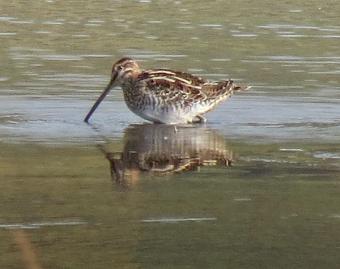 Snipe
The planned departure time of 4.15pm came too quickly but it was a very satisfied party who set off back to Bradford having enjoyed another most enjoyable BEES outing in weather that outwitted the forecast and stayed fine and sunny all day. There were suggestions on the return journey that perhaps we could consider making this trip an extended day out sometime in the future so as to be able to make the most of this excellent site.
Snipe
The planned departure time of 4.15pm came too quickly but it was a very satisfied party who set off back to Bradford having enjoyed another most enjoyable BEES outing in weather that outwitted the forecast and stayed fine and sunny all day. There were suggestions on the return journey that perhaps we could consider making this trip an extended day out sometime in the future so as to be able to make the most of this excellent site.
Many thanks to the day’s leaders and to Robert and Sue for their driving.
Stuart
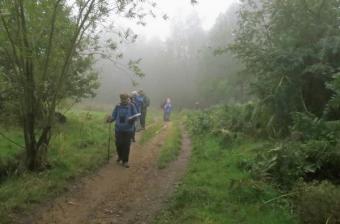 Misty Chevin
Misty ChevinSeasons of mists and mellow fruitfulness,
Close bosom-friend of the maturing sun;
Conspiring with him how to load and bless
With fruit the vines that round the thatch-eaves run;
John Keats Ode to Autumn
Thirteen of us gathered today to enjoy a walk in the Danefield estate on Otley Chevin. This area of land had been bequeathed to Otley council by the Fawkes family. It had been clear-felled during the Second World War and replanted with conifer and some exotic trees. There was an ethereal atmosphere as we made our way through the mist-enshrouded woodland in the direction of Caley Crags. The atmosphere was added to by the groups of colourful Fly Agaric fungi seen, known for their hallucinogenic properties and associations with the pixes, elves etc. The mist had lifted on arrival at our lunch spot and we enjoyed views of the Wharfe Valley below.
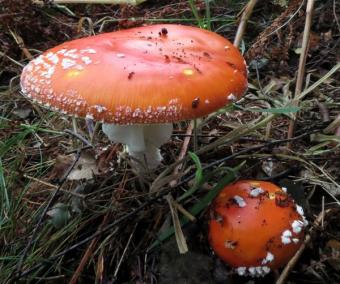 Fly AgaricTo bend with apples the moss’d cottage-trees,
Fly AgaricTo bend with apples the moss’d cottage-trees,
And fill all fruit with ripeness to the core;
Following lunch we enjoyed a ramble through an area of heath consisting of Bilberry, Ling, Heather and Bracken towards the pond and board walk. Here we spent time observing a superb Southern Hawker dragonfly in flight. We followed the Sculpture Trail on our return to the car park. Lots of fungi were seen growing in the conifer woodland.
In the afternoon we moved onto Crag House Farm, a Caring for Life project where we were treated to a celebratory birthday tea by the blog scribe in their superb Barn restaurant.
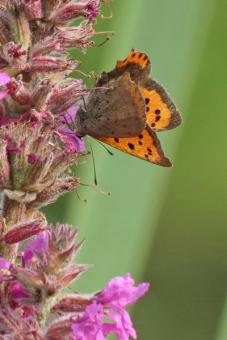 Small CopperTo swell the gourd, plump the hazel shells
Small CopperTo swell the gourd, plump the hazel shells
With a sweet kernel; to set budding more,
And still more, later flowers for the bees,
Until they think warm days will never cease,
For Summer has o'er brimmed their clammy cells,
Our exploration of the nature reserve continued in the afternoon sunshine. We saw trees and shrubs laden with fruit, late summer flowers and much to the delight of our young guest Eden, butterflies and dragonflies. A lot of hard work had been put into creating an oasis for wildlife.
This was a splendid and varied day out in an area close to our own doorstep. Some of the species seen were: Birds - 14 species in total including Tree Sparrow, Chiffchaff, Nuthatch, Sparrowhawk, Kestrel, Goldfinch. Dragonflies - Southern Hawker, Common Hawker. Butterflies - Red Admiral, Speckled Wood, Small Copper, Small Tortoiseshell, Large White. Fungi (identified by John) - Common Inkcap, Common Yellow Russula, Fly Agaric, Peppery Bolete, The Deceiver, The Blusher, Tawny Grissette, Wrinkled Club, Sulphur Tuft, Shaggy Scalycap, Snakeskin Grissette, Amanita Vaginata, Hairy Curtain Crust, Candle Snuff. Flowers (Joan and Alice did a comprehensive list) - Climbing Corydalis, Common and Musk Mallow, Black Horehound, Hemp Agrimony. Shrubs - Spindle, Elderberry, Guelder Rose, Rowan.
Margaret
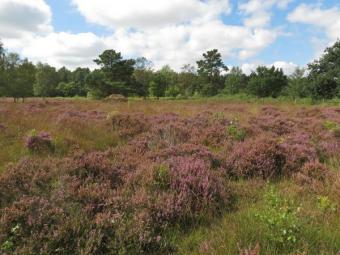 Allerthorpe CommonThe minibus was full for our trip to Allerthorpe Common which was led by Joan. En route a brief stop for toilet facilities also gave an opportunity to purchase bacon butties and the like for those who wished to indulge. The aroma in the bus was delicious. We parked in the car park of Allerthorpe Woods where we were met by Michael Knaggs, a member of the botany group who has good knowledge of this site.
Allerthorpe CommonThe minibus was full for our trip to Allerthorpe Common which was led by Joan. En route a brief stop for toilet facilities also gave an opportunity to purchase bacon butties and the like for those who wished to indulge. The aroma in the bus was delicious. We parked in the car park of Allerthorpe Woods where we were met by Michael Knaggs, a member of the botany group who has good knowledge of this site.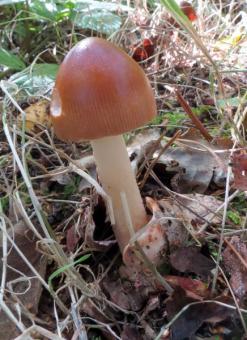 Tawny Grisette He led us on a short walk through the wood to the Common which is an enclave within the wood. Short in distance, however, does not mean short in time especially with BEES and with such an abundance of fungi.
Tawny Grisette He led us on a short walk through the wood to the Common which is an enclave within the wood. Short in distance, however, does not mean short in time especially with BEES and with such an abundance of fungi. The predominant fungi families were Boletes, Lactarias and Russulas. Highlights were Oakbug Milkcap, Brown Birch Bolete, the Blusher, Common Yellow Russula and Tawny Grisette which was seen at different stages of development. 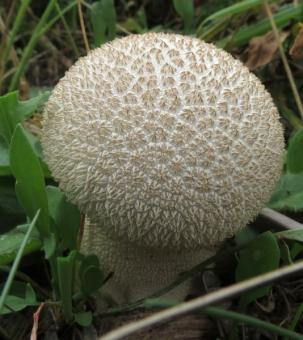 Dusky PuffballA Penny Bun was taken home by Dania. Numerous small Hoof fungi were seen growing on a dead standing tree.
Dusky PuffballA Penny Bun was taken home by Dania. Numerous small Hoof fungi were seen growing on a dead standing tree.
125 plants were recorded including three different types of heather. Notable plants included Small Nettle, Water Pepper and Common Hemp Nettle. John potted a moth which he identified as a male Chevron moth and a bright green caterpillar that hitched a ride on Joan's trousers was found to be a Beautiful Yellow Underwing caterpillar. Unfortunately we did not find any adders but we did see several lizards.Given that the weather has been pretty poor of late, 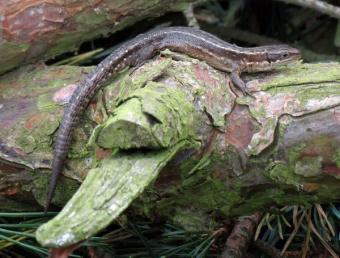 Lizard we were very fortunate to experience a bright day that grew increasingly warm.
Lizard we were very fortunate to experience a bright day that grew increasingly warm.
The warm weather had brought out some dragonflies including black darter, southern hawker, migrant hawker and common hawker. Butterfly sightings included peacock, small tortoiseshell and brimstone. Very few birds were seen, the prize species being buzzard and willow tit. We were grateful to Michael for giving up his time to lead us today. Thanks also to Joan for organising the day and Stuart for driving.
Sue
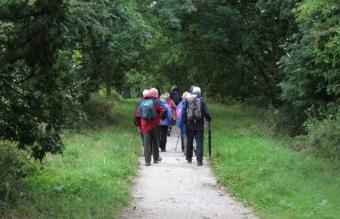 On "The Lines" RouteToday we commenced our exploration of the ten South East Leeds sites owned by Leeds Council which are now managed in partnership with the Yorkshire Wildlife Trust (YWT). The minibus left Bradford very promptly with ten members who were prepared for the heavy showers which were forecast for the day on our linear walk along the Lines Way, a four mile track along an old railway line which passes close by to the previously visited nature reserve of Townclose Hills.
On "The Lines" RouteToday we commenced our exploration of the ten South East Leeds sites owned by Leeds Council which are now managed in partnership with the Yorkshire Wildlife Trust (YWT). The minibus left Bradford very promptly with ten members who were prepared for the heavy showers which were forecast for the day on our linear walk along the Lines Way, a four mile track along an old railway line which passes close by to the previously visited nature reserve of Townclose Hills. We collected Stuart & Gillian who had left their car at the end of the walk at Allerton Bywater and proceeded to the starting point at Garforth where we had been very kindly offered a parking spot by Millrace Nurseries.
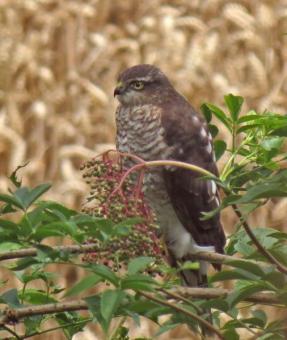 SparrowhawkWe made good BEES time in ever-improving weather which soon had everyone taking off their outer layers and we lunched whilst watching an air display put on by swallows, house martins and probably the last swifts that we will see on a BEES trip this year before the star of the show - a male sparrowhawk - did a fly past and came to rest in a nearby tree, allowing Sue to record the event on her camera.
There was plenty of botanical interest and Joan and Alice recorded a total of 166 plants, most of which were in flower. John noted 11 species of butterfly, including brimstone, painted lady and small copper whilst a few dragonflies and damselflies put in an appearance to add to the variety of the day.
SparrowhawkWe made good BEES time in ever-improving weather which soon had everyone taking off their outer layers and we lunched whilst watching an air display put on by swallows, house martins and probably the last swifts that we will see on a BEES trip this year before the star of the show - a male sparrowhawk - did a fly past and came to rest in a nearby tree, allowing Sue to record the event on her camera.
There was plenty of botanical interest and Joan and Alice recorded a total of 166 plants, most of which were in flower. John noted 11 species of butterfly, including brimstone, painted lady and small copper whilst a few dragonflies and damselflies put in an appearance to add to the variety of the day. 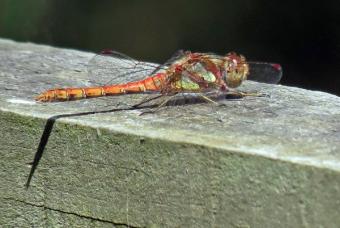 Common Darter
Common Darter
On reaching the end of the walk after lunch, Stuart conveyed Robert back to the start to collect the minibus so that we could proceed to our second site of the day, Ledsham Bank, a YWT reserve on the Magnesian limestone on the outskirts of Ledsham village. The main attractions of the site at this time of the year are autumn gentian and autumn ladies tresses and we were lucky to see both species as well as many other interesting plants such as rock rose, agrimony, betony, greater knapweed and viper’s bugloss. Another speciality of the site, dyer’s greenweed was present but had gone to seed. John showed us where the real star of the site – pasque flower - can be viewed and we made a note to organise a trip next year to try and see this rarity.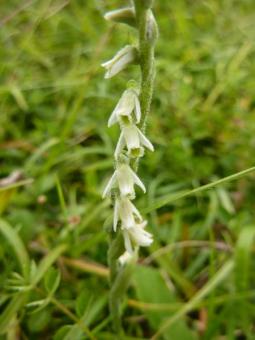 Autumn Ladies Tresses
Autumn Ladies Tresses
Birds were more abundant than on recent BEES trips and we recorded 24 including buzzard, whitethroat, red-legged partridge and willow warbler. We had only experienced a couple of very light showers during the day but as we concluded our visit the skies grew darker and heavier rain threatened as we boarded the minibus and headed off to the Chequers Inn at Ledsham for a comfort stop with refreshments before heading back to Bradford having had a very full day.
Thanks to Joan and Alice who had undertaken a very detailed recce of the area (which included negotiating parking spots) and who gave us a thoroughly enjoyable day out.